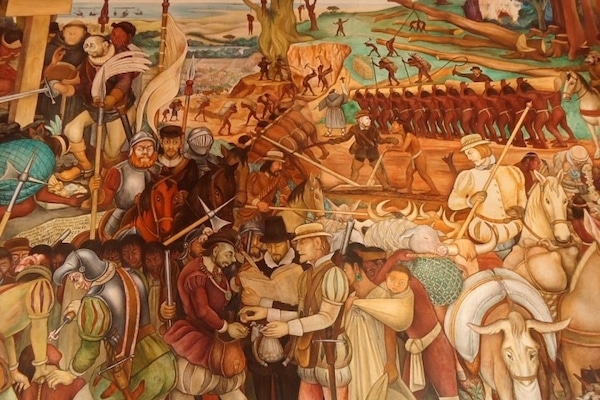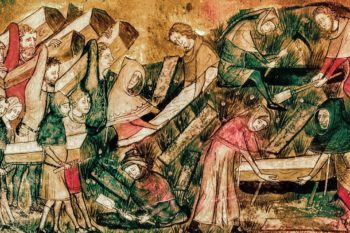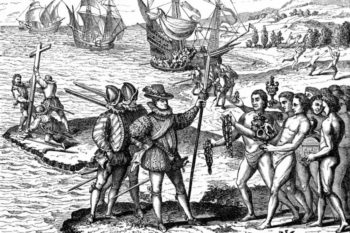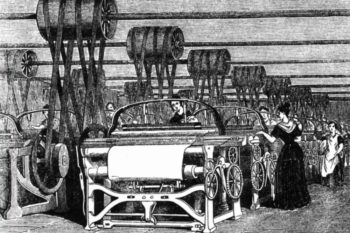Archive
Capitalism vs. Socialism: A Changed Debate

Once again, private capitalism’s contradictions, flaws and weaknesses threaten its own existence. Two major global collapses — first in the 1930s and more recently, since 2008 — plus periodic downturns every few years have underscored the instability that haunts the system. At the same time, deepening inequality has turned ever-larger populations into capitalism’s critics. Talk of reform and revolution has crowded onto political agendas. The capitalism versus socialism debate has returned everywhere. However, it is a changed debate transformed by lessons drawn from the Soviet Union and other similar experiences and experiments. The debate now displays three key alternative systems, not two: private capitalism, state capitalism and socialism. And that changes everything.
During the later nineteenth and twentieth centuries, we mostly believed ourselves to be caught up in a struggle between capitalism and socialism — as the two alternative economic systems differentiated by how the individual related to the state. Private versus public enterprises, free markets versus central planning: these were the epochal individual versus state oppositions that, especially in economics, took the form of capitalism versus socialism. But we know now that we should not equate the private-versus-public debate with a real consideration of capitalism versus socialism. Capitalism, we have learned, displays both private and state forms, and socialism differs from both of them. Capitalism, as we discuss further below, is a production system structured by its relationship of employer to employee as different persons or groups, regardless of whether employers are public or private. In contrast, socialism’s very different structure has employer and employee being the same person.
Reexamining past economic systems that coexisted with state apparatuses shows that they included both private and public enterprises. In many examples of slave economic systems, there were private masters alongside public masters. That is, private individuals or groups of citizens owned slaves, but so did local, regional or national state bodies and agencies. Likewise, in many examples of feudalism, we find private individuals who were lords ruling over serfs alongside, for example, kings or other state bodies who were also lords presiding over serfs.
Societies where slavery prevailed sometimes displayed struggles between the private and the state slave enterprises. Where feudalism prevailed, there were comparable struggles between the private and the state feudal enterprises. Such struggles sometimes broadened into grand oppositions between private and public, individual and state, citizen versus government, etc. But those struggles and oppositions usually occurred within one, shared class system: slavery or feudalism.
Capitalism has a parallel history. Private enterprises (owned and operated by private individuals and groups holding no position within any state apparatus) have frequently coexisted with public or state enterprises. The latter were owned by the state and operated by state officials. In both the private and public capitalist enterprises, the common basic relationship was between employer and employee. This matched the common relationship (master-slave) shared by private and public slave enterprises and the common relationship (lord-serf) shared by private and public feudal enterprises.
In slavery, feudalism and capitalism, the proportions of private versus state enterprises could and did vary. Public enterprises were sometimes a small and marginal portion of a region’s or nation’s total economy. They might also be altogether absent, or, at the opposite extreme, be the chief or even the only kind of enterprise. Depending on which form prevailed, economies could be described as private or state slavery, private or state feudalism, or private or state capitalism.
What obscured these parallels over the last century and a half was confusion between private versus state capitalism, on the one hand, and capitalism versus socialism on the other. Most people described the dominant opposition as capitalism versus socialism, but their definition of socialism equated it with state capitalism. They viewed capitalism as an economy based on private capitalist enterprises (or “free” enterprises) and markets as organizations for the distribution of enterprises’ resources and products. They viewed socialism as an economy of public enterprises (or “state” enterprises) and central planning as the organization for distributing resources and products. In effect, they conflated socialism with state capitalism.
These confusions of terms and meanings likely arose because nineteenth and twentieth century socialists focused strategically on capturing the state (either by revolution or by parliamentary politics). They planned to use the state as the means to transform capitalism into socialism. State capitalism would serve as a kind of way station where state capitalist enterprises and central planning prevailed (occupied the “commanding heights”) over private capitalist enterprises and markets. Such an economy would then be further transformed into socialism, presumably by the socialists who had captured state power. Socialists were often quite vague about their ultimate goal of socialism, especially when compared to their clear focus on political strategies to win state power and establish state capitalism.
Most socialists gradually stopped viewing the state as merely the means for (and state capitalism as a way-station to) a further transformation. Instead, state capitalism — operated by a state apparatus controlled by people who identified as socialists — came to be viewed as, in itself, the transformation of capitalism into socialism. Converting private to state capitalist enterprises and subordinating markets to central planning came to define the achievement of “socialism.” Two sequential transitions — the first from private to state capitalism and the second from state capitalism to socialism — were conflated into the first one alone.
The last century’s so-called great contest between capitalism and socialism was thus actually a contest between private and state capitalism. The US mostly favored private capitalism. It displayed chiefly private enterprises with significant instances of state capitalist enterprises; it likewise displayed a largely market system of distribution with significant instances of planned distributions. Meanwhile, the USSR was mostly a state capitalism. It displayed chiefly state capitalist enterprises and centrally planned distribution with significant instances of private capitalist enterprises and market distributions. However, most of its advocates and its critics alike described the USSR as “socialist.”
Historically, then, the revolution of 1917 achieved a transition from private Russian capitalism to Soviet state capitalism, while the 1989 implosion achieved precisely the reverse transition. In good dialectical fashion, those oscillations between private and state capitalisms enable us to clarify that socialism lies beyond them both.
The socialist alternative to both private and state forms of capitalism is the end, the supersession, of capitalism as the specific employer-employee organization of production. The replacement of private enterprises by state enterprises and markets by planning are changes that mostly leave in place the employer-employee organization of production, capitalism’s distinguishing mark. The employer-employee relationship in production differentiates capitalism from slavery (where master-slave is the distinguishing relationship). It differentiates capitalism likewise from feudalism (where lord-serf is the distinguishing relationship). Finally, the employer-employee relationship differentiates capitalism — in both its private and state forms — from socialism, in which the dualistic oppositions of master-slave, lord-serf, and employer-employee are all dissolved. In socialism — if we return to its original conception as a basic alternative to capitalism — the workers/employees themselves function as their own collective employer.
Worker coops — what might more precisely be called worker self-directed enterprises — are the core or definition of a socialist organization of production that is a systemic alternative to capitalism. In worker self-directed enterprises, no dichotomy of enterprise participants pits them against one another. No minority (masters, lords or employers) dictates to a majority (slaves, serfs or employees). Enterprises comprise a community of individuals democratically organizing all of their own work activities. The production process itself is thereby socialized. The socialization no longer applies merely to the ownership of means of production and the distribution of resources and products as in classical “socialism.” Worker self-directed enterprises democratize the enterprise, thereby providing more of a basis for the democratization of the economy and society than capitalism (private or state) could ever achieve.
Karl Marx’s analytical focus on exploitation — how surpluses are extracted from producers (slaves, serfs and proletarians) by exploiters (masters, lords and capitalists) — points toward a socialism that negates all forms of exploitation. In contrast, state capitalist enterprises change who the exploiters are and the conditions of that exploitation. State and private capitalisms can be and have been very different in their social consequences, political complexions, etc. Struggles between them have had momentous historical significance. But they did not end worker exploitation; they did not establish a socialist economy that banished exploitation.
For struggles between private and state capitalisms to become means for or steps toward transitions to socialism, their limits must be appreciated. The emerging twenty-first century socialism, focused on a system beyond state capitalism, represents both a return to Marx’s basic insights and a learning from the successes and failures of what the twentieth century called socialism. This will be a stronger, more developed kind of socialism, confronting a capitalism whose internal contradictions, flaws and weaknesses are now more widely appreciated than ever.
Richard D. Wolff
Freedom and Slavery: the Birth of Capital

We are frequently told that capitalism equals ‘freedom’; that it is the organic product of ‘human nature’. But far from arising naturally, the birth of the ‘free’ market is built on violence, dispossession, and enslavement.
The more individuals are left to trade and enrich themselves, the more capitalism thrives and consequently, the more free and prosperous everyone in society becomes – this argument is simple, familiar, and completely false. In reality, capitalist freedom has always had a deeply contradictory nature from the very beginning.
What the birth of capital required was that the owners of money, land and industry should be confronted by a mass of ‘free’ workers, liberated from any property of their own and completely reliant on the market. This is the real foundation of the capitalist system, and its history is “written in the annals of mankind in letters of blood and fire”, in the words of Karl Marx.
The Decline of Feudalism

It was amongst the crumbling ruins of feudal Europe that the foundations for a new social order were laid. But the first blows against the old order were struck neither by the merchants nor the money lenders, but by the poorest and most oppressed layer in feudal Europe: the serfs.
Medieval Europe was built on the unpaid labour of this class of semi-slaves, who were granted a small patch of land in return for which they were forced to work for free on the estates of the church and feudal nobility for several days a week. Added to this was ‘boon work’ or corvee, which required the serfs to perform specific tasks for the benefit of their lords. In England at the time of the Domesday Book (1086), it is estimated that as much as 70% of the population were classed as serfs. It is in the struggle of this oppressed class of peasants to free themselves from bondage that the pre-history of capitalism can be traced.
There is an old German saying, “Stadtluft macht frei”, which means “town air makes you free”. Its source is a customary law from the Middle Ages under which any escaped serfs who remained in a town for a year and a day would no longer be subject to the claims of their former lords and hence would become free. But this custom did not simply descend from heaven or come about by a gentlemen’s agreement between the rulers and their slaves. It was the product of years of bitter class struggle.
A serf was considered a part of the lord’s property, as if he and his family had grown out of the soil itself. He was consequently completely under the jurisdiction of his lord, meaning he had little opportunity to seek justice from anyone else. The king was himself just another landlord and the church was the biggest landlord of all.
The easiest and most effective defence against the lords’ exploitation was flight, and throughout the Medieval period a constant struggle thundered between serfs striving to escape the snatching grasp of the lords and their man hunters who roved the country in search of their lost property.
One result of this clash was many of the free towns of Europe. These ramshackle settlements, from such humble beginnings, would in some cases become powerful independent cities. Born out of feudalism and yet in opposition to it, the town dwellers, known in France as ‘bourgeois’, organised themselves into city councils and guilds, which served as local organs of power through which these collection of individuals, thrown together by common struggle, would be transformed into a class.
The growth of these towns and the rapid rise in population up to the Black Death contributed to a powerful upturn in trade, which began gradually to undermine the foundations of feudalism.
Engels remarks that “long before the ramparts of the baronial castles were breached by the new artillery, they had already been undermined by money” in his article, The Decline of Feudalism and the Rise of the Bourgeoisie. As early as the Crusades, some lords were beginning to demand money rents from their subjects in place of labour services, so that they could access the various luxuries and exotic products this trade brought into view.
But the more the lords exacted money rents from their tenants, the more both parties became dependent on the towns. Previously, the feudal manor had been a self-sufficient unit, combining both handicrafts and agriculture. The growth of the towns brought with it more specialised products such as tools and cloth for the masses as well as silks for the nobility. From this growing division of labour sprang a new relationship between the rural peasants and the bourgeois in the towns-a relationship mediated through commodities.
The 14th century represents a point of no return in the struggle against serfdom, which was already in decline in most of Europe. Rather than strengthening the lords against the peasantry, the crisis caused by the Black Death-which reduced the population of Europe by at least a third-actually gave the peasants themselves a great deal of bargaining power. The response of the lords was to try to impose a legal maximum on the wages of labourers and to crush the peasantry with taxation, of which the Poll Tax was the most infamous example.
The result was the Peasants’ Revolt in 1381 which, allied with the poorest layer of the London masses, took the form of a national uprising. Despite its brutal suppression this revolutionary movement succeed on two fronts: there was no further levying of the Poll Tax (until Thatcher’s ill-fated attempt to resurrect it), and serfdom in England was dead. In its place was an exhausted nobility, increasingly dependent on money rent, independent smallholding peasants and a growing bourgeoisie in the towns.
Engels remarks that in history the actions of the men and women who make history “ultimately have consequences quite other than those intended”. The struggle of the peasants and town dwellers had set the stage for a dramatic new act in world history, but no sooner had their freedom been won, so began a new wave of enslavement out of the fruits of their victory.
The World Market

The decline of feudalism gave a powerful spur to the production and exchange of commodities. The developing division of labour between the craft industry in the towns and rural agriculture created an expanding demand for goods of all kinds. And this demand was fed by an increasingly complex and powerful web of commercial routes across Europe and the Mediterranean.
First in Egypt then taken up by the Italian city-states, sophisticated legal instruments such as insurance contracts and trading companies were introduced to cover the risks associated with regular long-distance trade. And along with the growing power of the merchants came the rise of “that common whore of mankind”: money. The founding of merchant banks in the great trading cities of Italy, such as Venice, originally as a response to the needs of merchant ‘capital’ would then act back on this development, pushing it to greater heights.
By the 15th century the burgeoning commodity economy in Europe was straining against what appeared to be a natural limit. The production and exchange of greater and greater masses of commodities created a dire need for money as a means of circulation and payment. Further, producers of much sought-after luxuries in Asia would often only take payment in silver, having no need for European cloth.
The growing thirst for precious metals to feed the developing market could not be quenched by the relatively scanty produce of European mines. The result was the infamous ‘gold lust’ that drove European adventurers on a quest of global pillage we now call the ‘Age of Discovery’.
One particularly quaint myth associated with this period is that it came about as a result of some uniquely European spirit of enquiry and adventure. This would certainly come as a surprise to the Chinese and Arab explorers of the period. But Engels offers us the swiftest rebuttal of this romantic nonsense:
It was gold that the Portuguese sought on the African coast, in India and the whole Far East; gold was the magic word which lured the Spaniards over the ocean to America. (ibid.)
This fact was not lost on the native ‘savages’ who encountered our intrepid European adventurers, one of whom remarked of Cortes’ conquistadors in Mexico:
They lifted up the gold as if they were monkeys, with expressions of joy, as if it put new life into them and lit up their hearts….They crave gold like hungry swine. (quoted in Galeano, Open Veins of Latin America: Five Centuries of the Pillage of a Continent)
Everywhere the Europeans landed they discovered new wealth to bring home to sell at an enormous profit. Like old Midas, whatever they touched turned to gold, with calamitous results for the native peoples they encountered. Marx remarks (in Capital,vol. 3) that, “Merchant’s capital, when it holds a position of dominance, stands everywhere for a system of robbery, so that its development among the trading nations of old and modern times is always directly connected with plundering, piracy, kidnapping slaves, and colonial conquest.” Nowhere can this be more clearly seen than in the period following the discovery of the New World.
On 3 August 1492, Christopher Columbus sailed out of the Spanish port of Palos. His goal was to reach Asia by sailing west over the Atlantic. Instead, on 12 October he stumbled upon the Bahamas and a people called, in their own language, the Lukku-Cairi. In his diary, Columbus wrote:
They go as naked as when their mothers bore them, and so do the women, although I did not see more than one girl. They are very well made, with very handsome bodies, and very good countenances.
Historians estimate there were 1 million Tainos (of which the Lukku-Cairi were part) in 1492. 56 years later there were only 500.
This became a model for the colonisation of the rest of the Americas. Wiped out by unfamiliar diseases (sometimes deliberately), sent to an early death in poisonous mines, almost 100 million human beings were sacrificed at the altar of Commerce. The price of their lives was the 100,000 metric tonnes of silver exported to Europe from Latin America between 1492 and 1800.
Then as now, defenders of this genocide pointed to the benefits of European freedom that were being forcibly administered to the natives. One such pious servant of God, Archbishop Liñán y Cisneros explained:
The truth is that they are hiding out to avoid paying tribute, abusing the liberty which they enjoy and which they never had under the Incas. (quoted in Galeano, ibid.)
But these European liberators didn’t just free the indigenous population of their lives and treasure; each site of human sacrifice became a fresh link in the chain of the growing world market, demanding an intensification of production by the most barbaric means. As the native population of the Caribbean dwindled, it was replaced by African slaves and sugar plantations first trialled by the Portuguese on Cape Verde.
Rather than developing production on a higher level, the original achievement of the world market was to extend and intensify the slavery of old on an ever expanding scale. By the end of the slave trade in 1853 between 12 and 15 million Africans had been transported, of whom as many as 2.4 million died on route.
This horrific slaughter was an integral part of the early development of capitalism. This was not lost on Marx, who emphasised (in Capital vol. 1):
The discovery of gold and silver in America, the extirpation, enslavement and entombment in mines of the indigenous population of that continent, the beginnings of the conquest and plunder of India, and the conversion of Africa into a preserve for the commercial hunting of blackskins, are all things which characterise the dawn of the era of capitalist production.
And yet, this period confronts us in one respect as an immense contradiction. On the one hand we see a developing world market with the ever-expanding production and exchange of commodities; but on the other, the methods used to produce these commodities remain nothing more than the intensification of pre-existing forms of exploitation to an agonising pitch.
Capitalism without commodities or money is unimaginable, but these still do not equate to capitalist production. What is required is for labour-power, the ability of human beings to work, to itself become a commodity. This final, decisive, stage in the birth of the capitalist system took the form of an immense social revolution which began in England in the 16th century.
The Agrarian Revolution

In 1516, the famous Tudor lawyer and writer Thomas More observed:
Yea and certyn Abbottes, holy men no doubt…leave no ground for tillers, thei enclose al into pastures: they throw downe houses: they plucke downe townes and leave nothing standynge but only the church to be made a sheephowse… (quoted in Morton, A People’s History of England)
What he was describing was a revolution, waged by the rich against their own people.
The end of serfdom had dealt a heavy blow to the power of the lords, but they still retained ownership of great swathes of land. It was from this position that the old masters began their counter-offensive against the free peasants of England.
The expansion of trade in the 14th century had also created a growing demand for wool, of which England was a major exporter. In response to this demand, landlords began forcibly evicting their feudal tenants in order to convert entire villages into sheepwalks. The importance of this lucrative trade for the English nobility can even be seen today in the woolsack upon which the Lord Speaker still sits in the House of Lords.
The result of this barefaced robbery was on the dispossession of thousands of peasants, many of whom had no choice but to roam the land looking for work or charity. The problem had already become so widespread that in 1489 Henry VII passed the first of a series of Acts which sought to curtail the depopulation of the countryside.
The discovery of the Americas and the gigantic upswing in trade that came with it only added fuel to the fire. Throughout the Tudor period, agricultural production was shifted towards cash crops for the market, with a new breed of capitalist farmers employing landless paupers as labourers.
Even this new mode of production proved insufficient to soak up the flood of poverty, however. Eventually, the class of pauperised ‘vagabonds’ became so large that it caused Queen Elizabeth I to introduce a special “Poor Rate” as early as 1601 whilst at the same time providing for “unlicenced beggars” to be executed “without mercy” as felons.
In the 17th and 18th centuries, the expropriation and displacement of the rural masses took on an official form through the passing of a series of Enclosure Acts in Parliament. This was catastrophic for the rural population – it had effectively driven the English peasantry to extinction by the 19th century – but it provided an enormous army of propertyless labourers for the growing industries in and around the towns. It was this process of legalised theft that gave birth to the capitalist ‘property rights’ so admired by modern defenders of capitalism.
The State
Another myth that surrounds the birth of capitalism is that it was achieved by the pioneering economic activity of enterprising individuals, in opposition to the dead hand of the state. This fairy tale is regularly dusted off whenever the modern state is forced to pass reforms by the pressure of the workers, but nothing could be further from the truth. At all points our future captains of industry and commerce depended on the most brutal state repression to protect their class interests.
Absolutism arose out of the contradictions of dying feudal society: a feudal monarchy resting alternately on landowners, bourgeois and peasantry. With one hand it placed checks on the expropriation of the peasantry but with another, usually acting in its own interests, actually hastened the development of capitalism.
The sale of lands expropriated from the Church after the Reformation at cut down prices, for example, was an enormous gift to the nascent capitalist farmers of the 16th century. Likewise, the establishment of colonial monopolies by all the absolutist monarchies of Western Europe, provided essential protection for the early development of manufacture.
However, precisely because of its transitional and contradictory nature, at a certain point this form of the state comes into a stark conflict with the interests of the bourgeoisie. Once the bourgeois had seized economic dominance, it must be able to rule in its own interests. And so the last vestige of the feudal political system became just another fetter on the great drive for accumulation which was taking root.
Beginning with the Dutch War of Independence a wave of revolutions swept Europe as the bourgeoisie took the road to political power. In its struggle against the old order, it united all that was healthy and progressive in society behind its call for ‘liberty’. Sweeping away the particularism of the past, the revolutionaries cleared the way for the development of a truly national market. In place of the arbitrary privileges of absolutism, they demanded the ‘rule of law’, which in practice has always meant the rule of the bourgeoisie.
But the great and tragic contradiction of all these movements lay in the fact that, as in the English Revolution, they ultimately delivered power not to the peasants and artisans who formed the ironsides of the revolutionary armies, but a new, even more powerful class of exploiters-something our modern lovers of liberty tend to forget.
Following the burial of absolutism the state came fully into the possession of the new landed aristocracy, ‘bankocracy’ and large manufacturers, either in the form of a republic or, more commonly a ‘constitutional’ (that is, tame) monarchy.
Anyone who doubts the significance of this for the development of capitalism need only look at the measures taken by the English Parliament after the so-called Glorious Revolution in 1688: Enclosures were transformed from a widespread abuse to a deliberate policy; the Bank of England was created along with the ‘National Debt’ – a debt to none other than capitalist speculators; further legislation to impose a ‘maximum wage’ was imposed, while combinations of workers to negotiate better pay and conditions were, of course, forbidden.
The concentrated power of the state was used “to hasten, hot-house fashion, the process of transformation of the feudal mode of production into the capitalist mode, and to shorten the transition,” Marx writes in Capital (vol. 1), adding,
Force is the midwife of every old society pregnant with a new one. It is itself an economic power.
It might also be noted that in this Golden Age of Liberty and Enlightenment, not a single worker or poor peasant had either a vote or political representation in any form. In reality the rising capitalist landowners and manufacturers needed the power of the state to ‘regulate’ wages and lengthen the working day.
In fact, it is only when their own miniature tyranny in the workplace is secured that the capitalist class will tolerate any political freedoms on the part of the workers, and even then, these are to be limited so as not to infringe upon their sacred right to ‘private property’, that is, the fruit of centuries of theft.
The Birth of the Working Class

The development of society is in the last instance determined by the development of humanity’s productive forces. But on its own technology is incapable of changing society – it is itself socially determined. The ancient Greeks had discovered steam power long before bourgeois Europe. Even the German inventor, Anton Müller produced a loom capable of weaving several pieces of cloth at the same time as early as 1529. The result was not the industrial revolution but, on the contrary, the murder of the inventor by the local city council.
In England, the agrarian and political revolutions of the 16th and 17th centuries laid the basis for the industrial revolution. Without the creation of a ‘surplus’ population of proletarians, the rising productivity of agriculture, and the gigantic boons granted to the capitalists by their conquest of political power, such an enormous social transformation would have been unthinkable.
The newly created proletariat was quickly put to work, usually under the whip of brutal repression, but one more obstacle to the unfettered freedom of capitalist exploitation remained: the guilds. By imposing strict rules and restrictions on the industry the guild system, which was itself a product of the struggle of the early bourgeoisie, became a suffocating fetter on the free development of the capitalist mode of production. In fact, the first manufacture of woolen cloth recorded in 16th century was shut down by the local guilds precisely because it threatened their monopoly.
The first cotton spinning mill was actually set up outside of any major town, in Royton, Lancashire, in order to avoid the resistance of what remained of the guilds in 1764. This quickly established a pattern for what would become the factory system. As one writer noted in 1773:
Working-men are driven from their cottages and forced into the towns to seek for employment; but then a larger surplus is obtained and thus capital is augmented. (J Arbuthnot, quoted in Marx, Capital, vol. 1)
Here lies the secret of capital: Not private enterprise but the sweated labour of others; not property rights but the absence of property for the many.
Eventually, the wage limitations which had been in place for centuries were finally repealed in 1813. They were now “an absurd anomaly” according to Marx, as the capitalists could freely dictate their workers’ wages and conditions as they pleased. The advance of capitalist production (helped by the mailed fist of the state) had finally developed “a working class which by education, tradition and habit looks upon the requirements of that mode of production as self-evident natural laws.”
As this newer, more ‘civilised’, form of exploitation took over more and more spheres of production, the British ruling class suddenly discovered that the slaves working its colonial plantations were human beings too. But when it finally abolished slavery in its colonies in 1833, the British government paid out £20m to compensate not the slaves but the 3,000 families that had owned slaves for their loss of ‘property’. This figure represented in today’s terms around £16.5bn: an enormous gift to the slave-owners, which they promptly put to use in English factories, Irish farms and Indian plantations.
Slavery was not abolished because it was immoral; it was abolished because it was unprofitable. It would be foolish to persist in such an expensive and unproductive enterprise when a shrewd investor could squeeze a never-before-seen profit from the blood of the ‘free-born slaves’ of Britain and its colonies.
But the creation of the working class gave a double gift to the capitalists. Not only did it create their profits from the workers’ surplus labour; it also created the means by which those profits could be realised – the first ever truly mass consumer market.
The average peasant never tended to buy much food or clothing because he would grind his own corn and weave his own cloth. The dispossession of the peasantry meant that not only were they dependent on the capitalists for work and wages, they also had to spend those wages on basic necessities like food and clothing from none other than the same capitalists (looked at on a national scale).
Later, in the 19th century, the British state used tariffs to destroy the Indian home-spinning industry and flood the market with cloth, often spun from Indian cotton. The role of India as a colony thus shifted from solely being a source of loot (which it remained) to also being an enormous captive market. In this way, the Indian masses, like their British counterparts, paid twice for their exploitation by the British capitalists.
This played an important role both in the rise of British capitalism and the struggle for Indian independence. In 1921, the Indian National Congress adopted a flag containing a picture of a spinning wheel to symbolise the home industry destroyed by British-rigged competition. This spinning wheel still survives (in part) in the Indian flag today, although it was changed into a Buddhist chakra wheel.
The importance of mass consumption to capitalism can be seen today on an even grander scale. The effect of this in our culture is the rampant consumerism and debt which bears down on us as individuals like a force of nature. We must not only work; we must buy. In this sense, supply determines demand as much as demand determines supply.
A New Fight
Capital now emerged, fully formed and “dripping blood from every pore” (to use Marx’s expression). Ever since, the freedom of capital has continued to find its reflection and source in the unfreedom of human beings. But it has also laid the basis for a new and greater fight.
Just as the bourgeoisie, a class born of the struggle between the feudal lords and serfs, was eventually able to seize power, transform the state to its own ends and wield it to eliminate the old order, so too can the working class, itself created by capitalism’s infinite drive to exploit human labour-power.
Like the medieval serfs, the workers of today give up most of their lives for a parasitic class of property owners. But by taking the immense productive forces created by their own labour into the hands of society as a whole, the workers of the world can put an end to class oppression for good, and usher in a new era of genuine freedom for the whole of the human race.














When Systems Crumble: Looking Beyond Global Capitalism
As global capitalism staggers painfully, unevenly and dangerously in the wake of its 2008 collapse, its critics divide into two broad camps. One commits to fixing or reforming a capitalism that has somehow lost its way. The other finds capitalism irreparably inadequate and seeks transition to a new and different system. The two camps see many of the same faults: how capitalism relentlessly deepens inequalities of income, wealth, power and access to culture; capitalism’s instability (those socially costly cycles it never managed to prevent); and its consequent injustices. Sometimes the two camps can ally and work together. However, at other times — such as now — the camps become more wary of, disaffected from, and competitive with one another. Adding complexity these days, the critics favoring system change are also redefining — for potential recruits and for themselves — the new system they seek.
Parallel divisions among critics also emerged in the crumbling of slavery and feudalism. As slavery declined, in the US as in the many other places it had existed, one group of its critics focused on improving slaves’ lives. It sought better diets, housing and clothing; more respect for slave families; and less violence toward slaves. Such critics wanted to reform a slavery that was too harsh. Another group of critics, diverging increasingly from the first, saw the problem as slavery itself. It wanted system change expressed in the demand for “abolition,” for social transition via emancipation, to a regime of universal individual freedom.
As the feudal economic system and the absolute monarchies that characterized late feudalism declined in Europe, critics of both split similarly. One side wanted to ease feudalism’s harsh edges: lords should be more accommodating to serfs, less rapacious for rents and other feudal dues imposed on serfs. The reformers of the feudal economy often partnered with the reformers of feudal monarchies. The latter favored councils or parliaments that could advise monarchs, constrain their powers via constitutions, and so on. On the other side were critics who responded to late feudalism’s accumulating problems, injustices and breakdowns by advocating the end to both feudal economic relationships and monarchies. They fought for economic freedom (ending serfs’ obligations as enforced by tradition, the church and the lords’ power) and its political correlate, a more or less democratic republic (ending monarchy).
Ideological Splits Intensify as Capitalism Declines
As contemporary capitalism declines now in its old centers (western Europe, north America and Japan), the split among its critics intensifies. Capitalism’s 2008 global meltdown, the government bailouts chiefly of big private businesses that had caused the crisis and the austerity policies that made the public pay for the bailouts stimulated surges of criticism. Yet another stimulus has been the behavior of capitalism’s mainstream advocates, the neoclassical economists controlling academic departments for as long as they can, and their former students who became status-quo-favoring politicians and journalists. As celebrating private capitalism becomes ever harder, strident extremism by capitalism’s defenders (expressed in various market and “free enterprise” fundamentalisms) frequently results.
The Keynesians, marginalized since the 1970s, returned after 2008 with renewed vigor to “save capitalism from itself” (Hillary Clinton). Paul Krugman, Joseph Stiglitz and many others keep enumerating how government must intervene to make modern capitalism work for all (“be great again?”). Government interventions, they warn, are the only way to regain the economy’s levels of performance and popularity before the 2008 meltdown, which exposed private capitalism’s accumulated, and by then, extreme fragility. The Keynesians want government to stimulate demand via deficit spending on labor-intensive projects, to redistribute income via tax policies, to run green New Deals, and so on. For the Keynesians, the neoliberal program of privatization, deregulation and globalization associated with Reagan, Thatcher and their successors failed to learn the lessons of the 1930s Great Depression. Thus, their neoliberal capitalism has taken the world economy down since 2008.
The debate pitting neoclassical/neoliberal economists against Keynesian adversaries is hardly new. It has informed oscillating policy regimes since the 1930s. Most participants on both sides speak and write as if their debate is the core issue of economics and always will be. It may be relevant that their academic and policy careers depend on that.
However, across capitalism’s entire history, it always generated critics who went further than reformers of capitalism and their arguments about economic policy interventions by government. Such critics found the debates between neoclassicals and Keynesians of secondary or less relevance. They believed that capitalism’s problems were so deep, so intractable and had so deftly evaded successive reformers’ (including Keynes and Keynesians) solutions that basic system change was needed. The term “socialism” is problematic to use in this context because it has taken on too broad a range of meanings. For example, many reformers of capitalism, including many Keynesians, refer to themselves as “socialists,” much as their political enemies often do. Likewise, many systemic critics of capitalism who reject Keynesian reformism insist on the label “socialist.” Much the same multiplicity of meanings applies to “communist.”
Effects of the Collapse of the Soviet Union
Adding complexity to the now growing number of capitalism’s systemic critics is a historic change in many of their arguments and foci. Before and after the Soviet (1917) and Chinese (1949) revolutions, the system-change critics had favored a much greater role for government in the economy than anything proposed by the Keynesians. Government was not merely to regulate capitalist enterprises but also to socialize them, to convert them from private into state-owned, state-operated enterprises. Likewise, beyond merely regulating market exchanges, government central planning was itself to distribute resources and products. The system-change critics sought to replace private enterprises and markets with state enterprises and planning. Capitalism and socialism were thereby systemically defined and differentiated. The 20th century’s systemic struggles and debates pitted the virtues and benefits of private enterprise and markets against those of public enterprises and government planning.
The 1989 collapse of the USSR and its Eastern European allies, and subsequent changes in the Peoples Republic of China (PRC) provoked many system-critics of capitalism to rethink their analyses and refocus their strategies. The transition from private enterprises and markets (capitalism) to public enterprises and planning (socialism/communism) had proven unsustainable. More importantly, the genuine economic and social gains that had been achieved were accompanied by serious failures that compromised what system-change critics had promised and expected. The traditional concept and goals of socialism/communism established in the USSR, PRC and beyond had proven significantly problematic.
Giving the state apparatus so central a role in the economy reinforced an excessive concentration of state power in politics, and culture too. Likewise, substituting state officials for private boards of directors left enterprises’ authoritarian internal organizations too little changed. The mass of workers resented and often undermined that organization, thereby frustrating the industrialization goals set by the state and eventually, the state-dominated system as a whole. Slowly these problems fostered an understanding that the concept of socialism/communism, and thus the goals of system change beyond capitalism, needed change.
In this new view, the capitalist system had not changed — or at least not changed enough — by making private enterprises public and distributing resources and products by plan instead of market. Inside workplaces, the same hierarchies of control, the same basic divisions among employers and employees, managers and managed, had remained. Thus, the actual transitions accomplished were from a private to a state form of capitalism. Those changes in the form of capitalism were mistaken for change to a system other than capitalism.
Rekindled Interest in Worker Cooperatives
Often, via reengagements with Marx’s writings, system-critics refocused their general attention on production, and more specifically, on the organization of the enterprise. Capitalism was redefined as a specific relationship among participants in producing goods and services. Much as slavery was defined in terms of slaves and masters and feudalism in terms of lords and serfs, capitalism was to be defined in terms of employers and employees. What became the crucial issue and focus was that relationship inside enterprises and not the secondary matter of whether the employer was public or private. What defined capitalism was the employer-employee relationship; what defined the preferred other system — whether called socialism or communism or neither — was a radically different relationship.
Posing the question of the exact nature of another system with a production relationship radically different from capitalism’s led many critics to rediscover worker cooperatives (sometimes called producer cooperatives). They were enterprises whose internal organization was not divided into employers and employees, i.e. different groups occupying different positions with some deeply opposed interests. For capitalism’s systemic critics, worker cooperatives entailed enterprises organized democratically — all workers would have individual, equal voices in making all enterprise decisions. What to produce, how and where to produce, and what to do with the enterprise’s net revenues or income would be decided democratically and collectively. Such enterprise organization constituted a genuinely different post-capitalist system.
Many system-critics of today’s capitalism are thus focusing increasingly on an economic transition from hierarchical capitalist enterprise organization to enterprises organized more horizontally as democratic worker cooperatives. Workers become their own directors, replacing corporate boards of directors elected by shareholders, and workers’ self-directed enterprises succeed capitalist enterprises in both private and public spheres (the relative proportions varying with the histories and preferences of different countries). The transition from capitalism to a specific next system — as the preferred solution to the problems of global capitalism today — is centered on the transformation of workplace organization as the key missing element that undermined previous efforts to move beyond capitalism (i.e., traditional socialisms and communisms).
When systems crumble and their critics divide into the two camps, the reformists usually prevail before the system-changers have their opportunity. In the longer run, we know from history, both the slave and feudal systems (the slave-master and the lord-serf workplace relationships) were largely abolished. Is capitalism, the employer-employee relationship, now also crumbling?
Richard D. Wolff
Source: